What is a A Portal to Gwoździec?
a space where we can illuminate the history of the Gwoździec Synagogue

“There were once hundreds of wooden synagogues in the Polish-Lithuanian Commonwealth. The German occupiers burned to the ground those still standing in 1939. They no longer exist. While we can never recover the original objects in the sense of the original material, we can, however, recover the knowledge of how to build them by actually building one.”
Forward from Gwoździec Re!construction, Warsaw, 4 September 2014
- Chief Curator of the POLIN Museum Core Exhibition: Barbara Kirshenblatt-Gimblett
Reconstructing Gwoździec Synagogue
The Gwoździec Synagogue was one of hundreds of wooden synagogues that once stood in the greater Polish-Lithuanian Commonwealth. By 1939, all were destroyed. In 2010, Handshouse Studio was invited to take on the project of recreating, as accurately as possible, the timber roof, painted wooden ceiling, and carved wooden bimah of the Gwoździec Synagogue for permanent installation at the POLIN MUSEUM for the History of Polish Jews in Warsaw, Poland.
The Gwoździec Re!construction
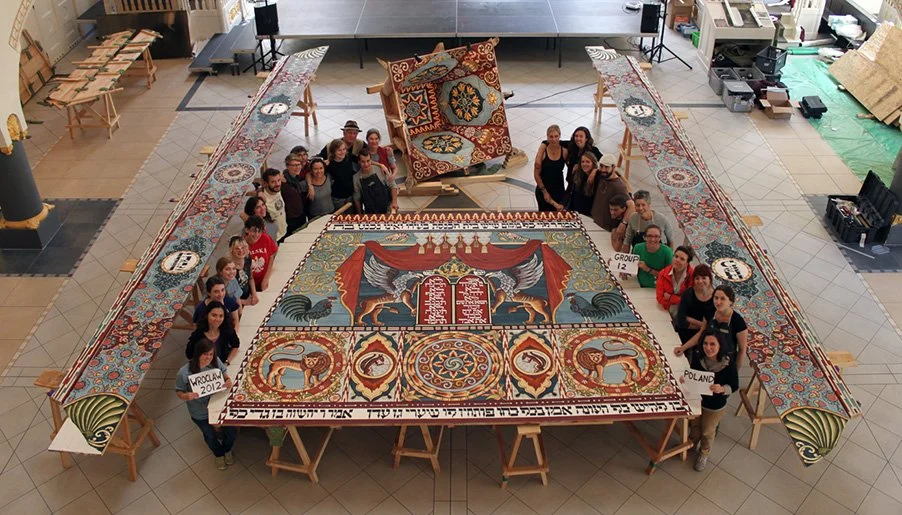



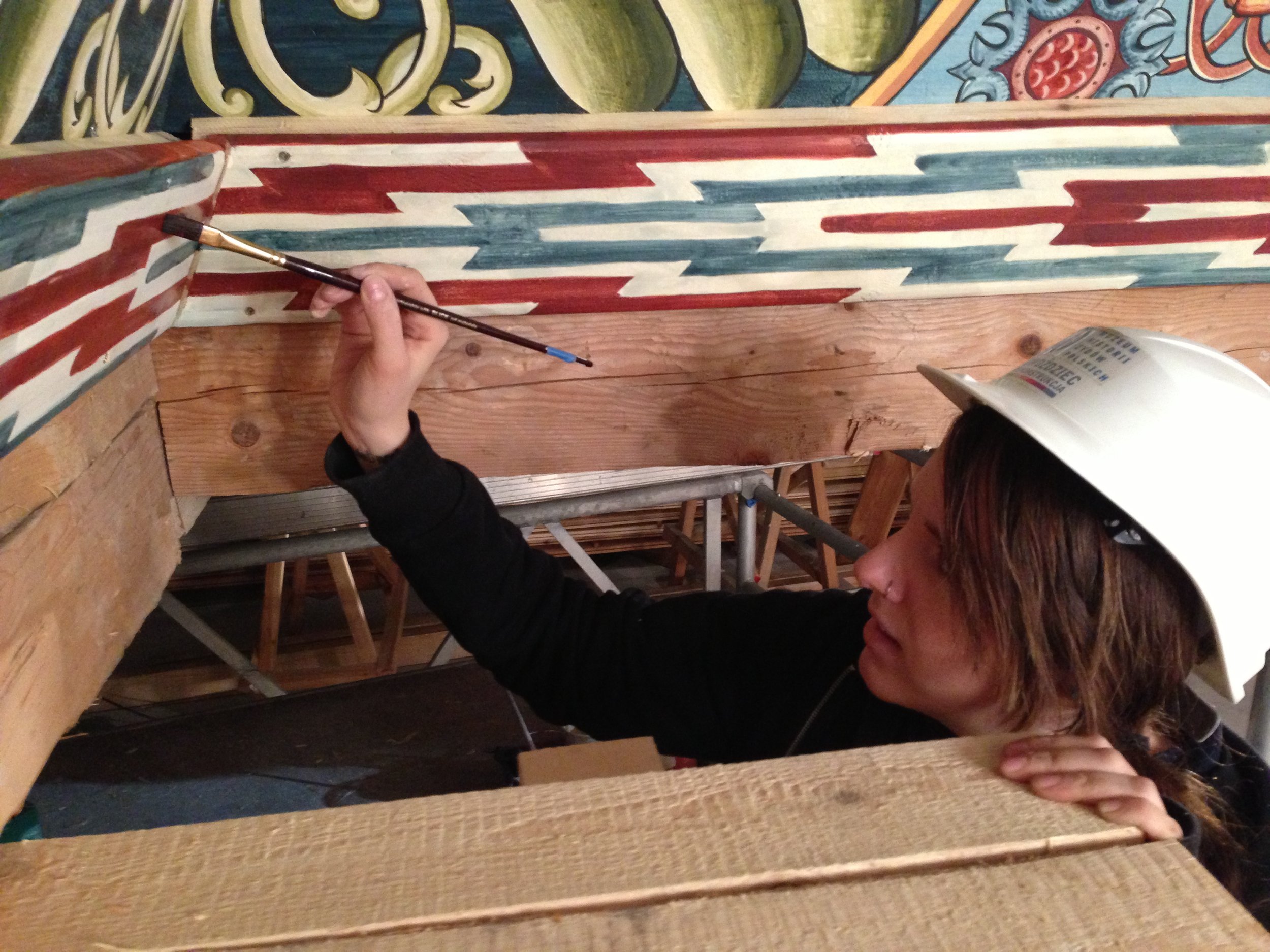
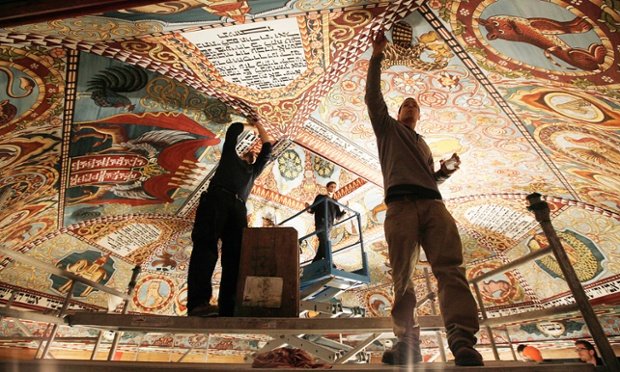
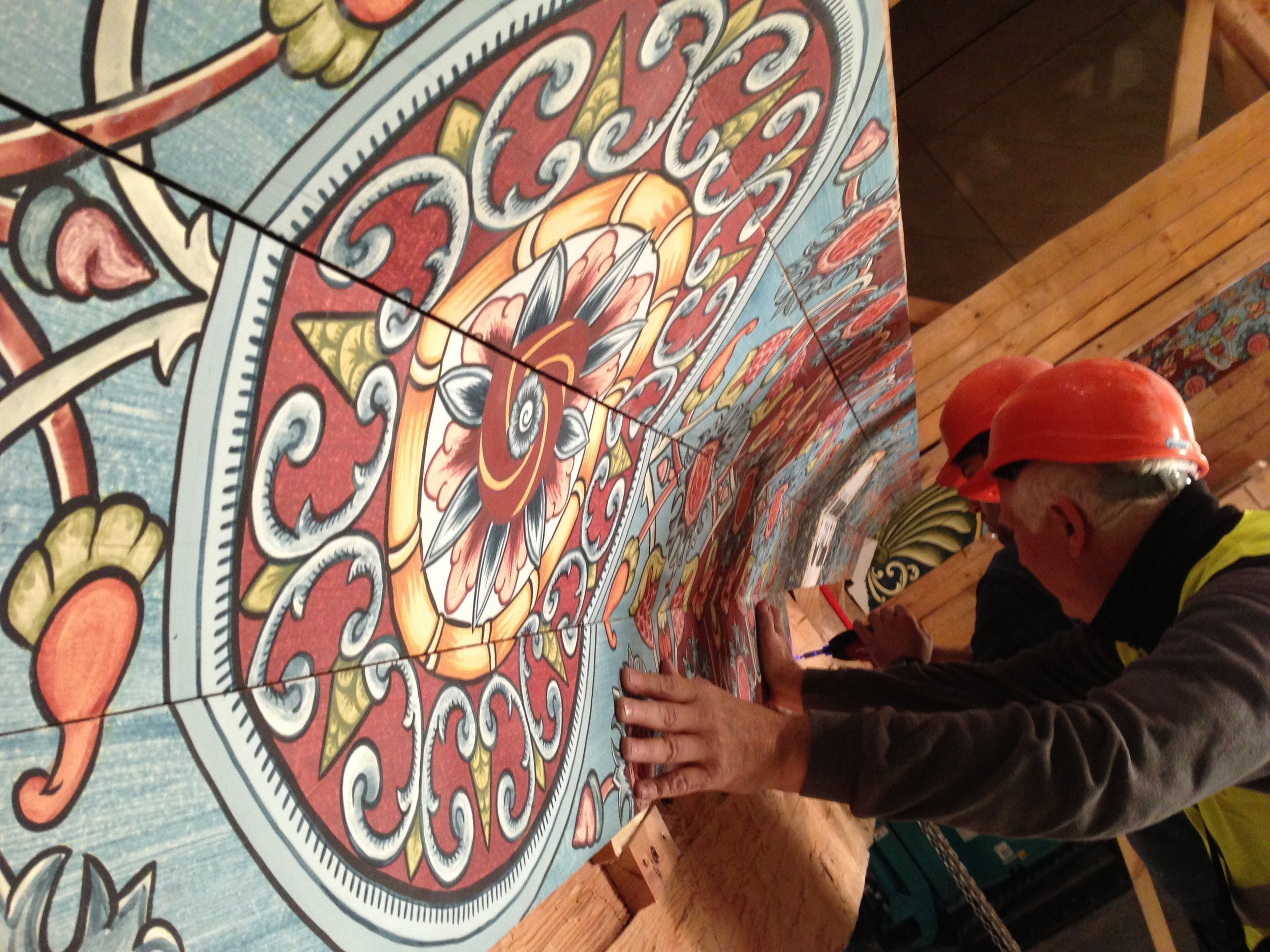

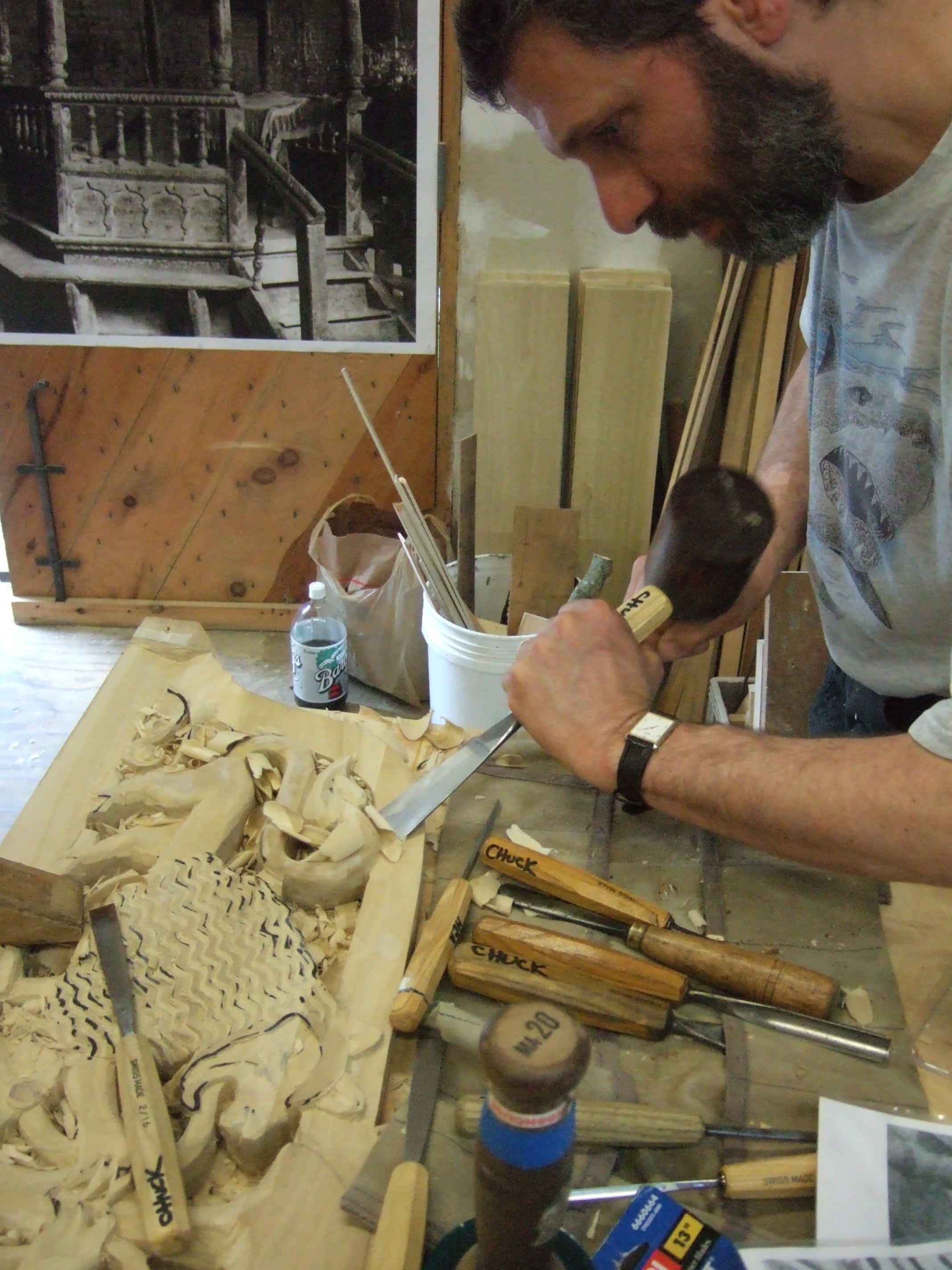


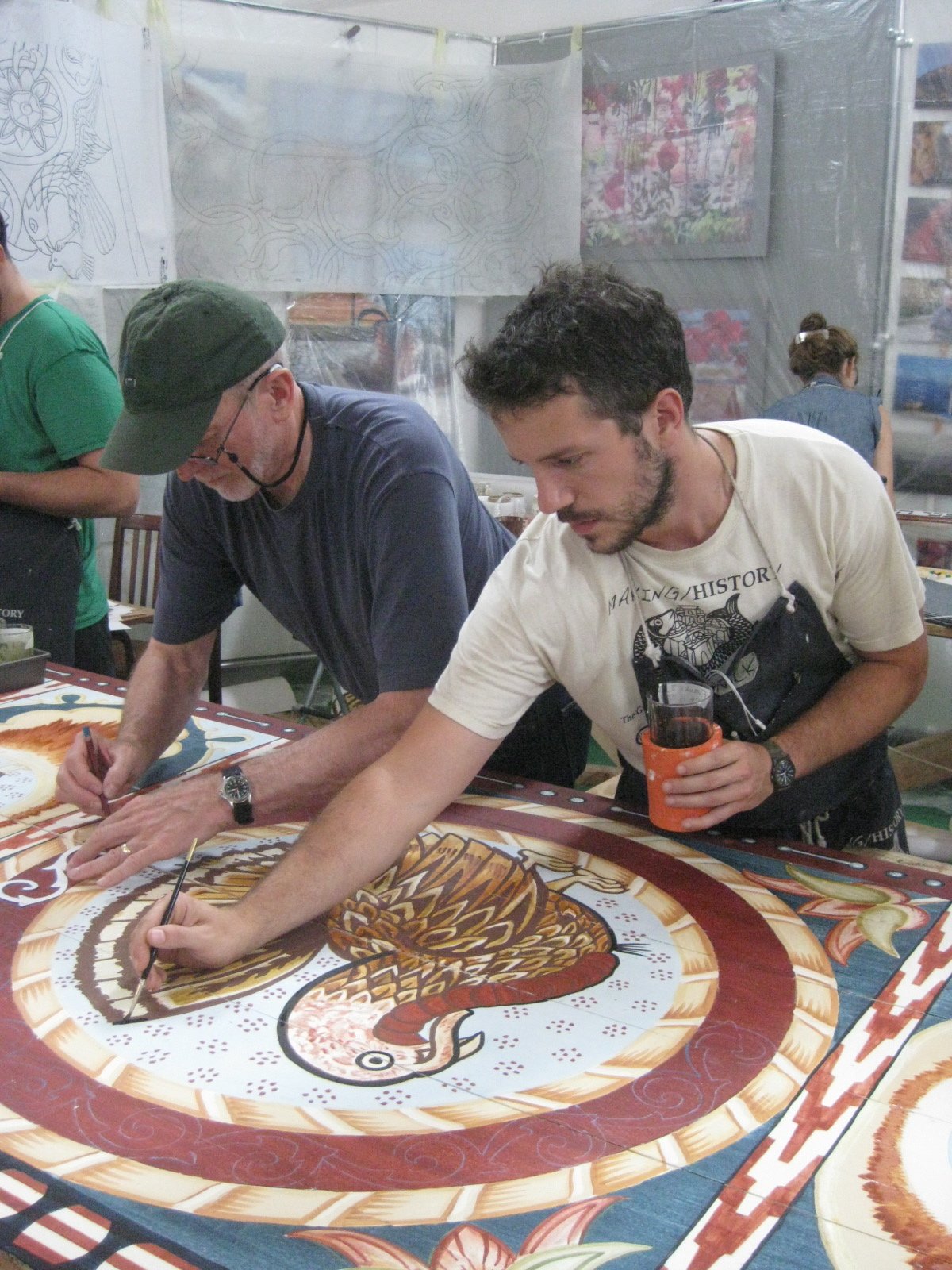
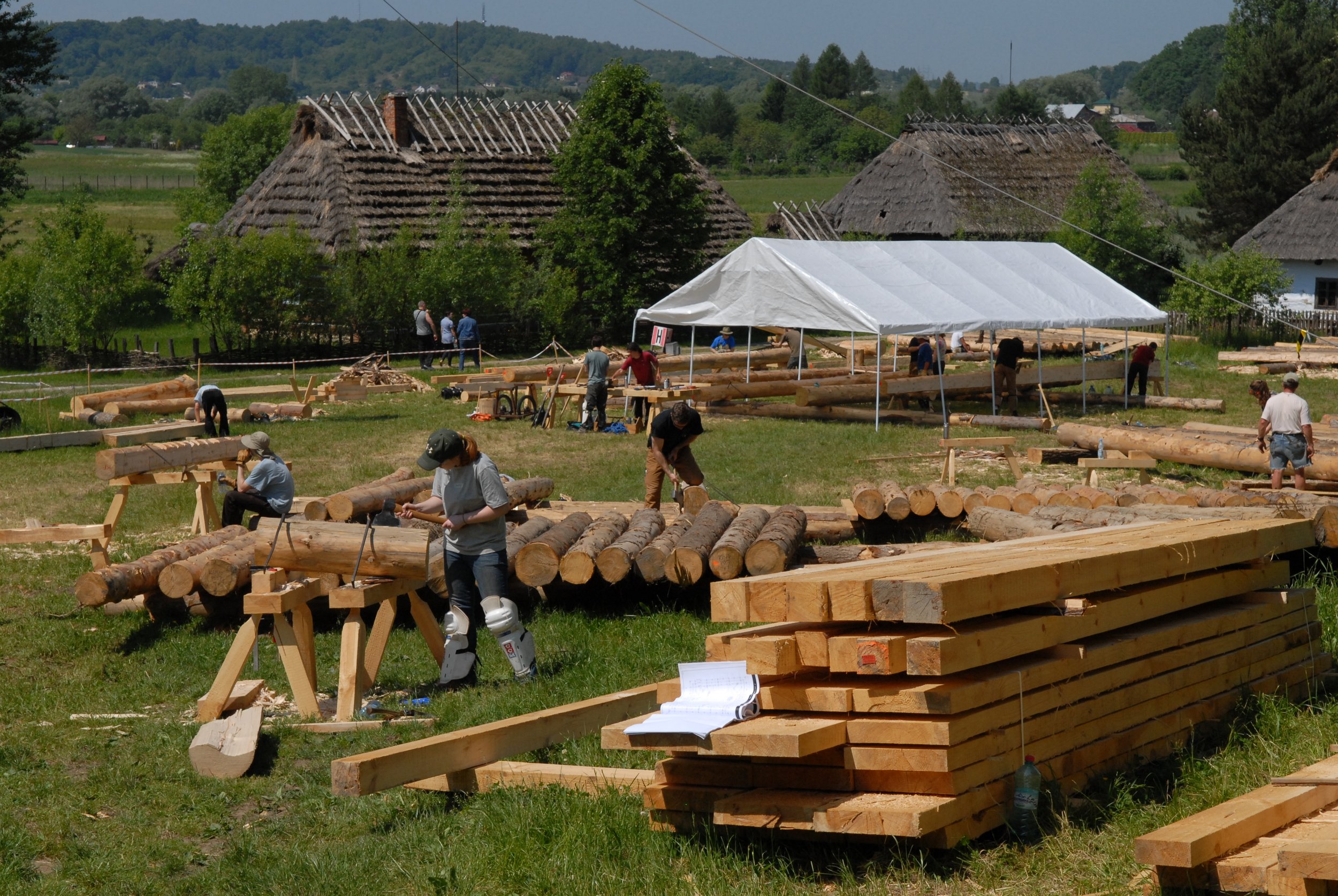

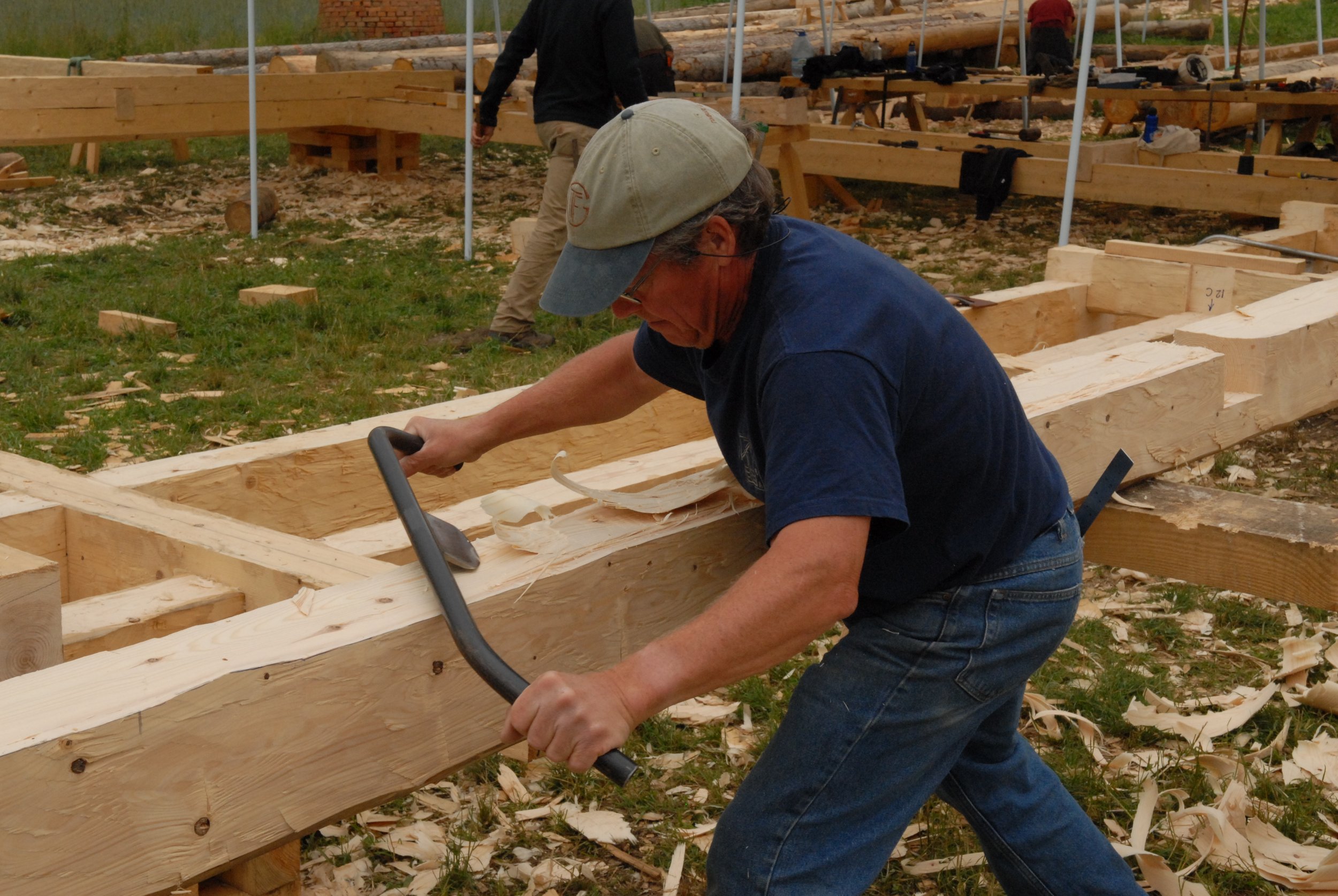


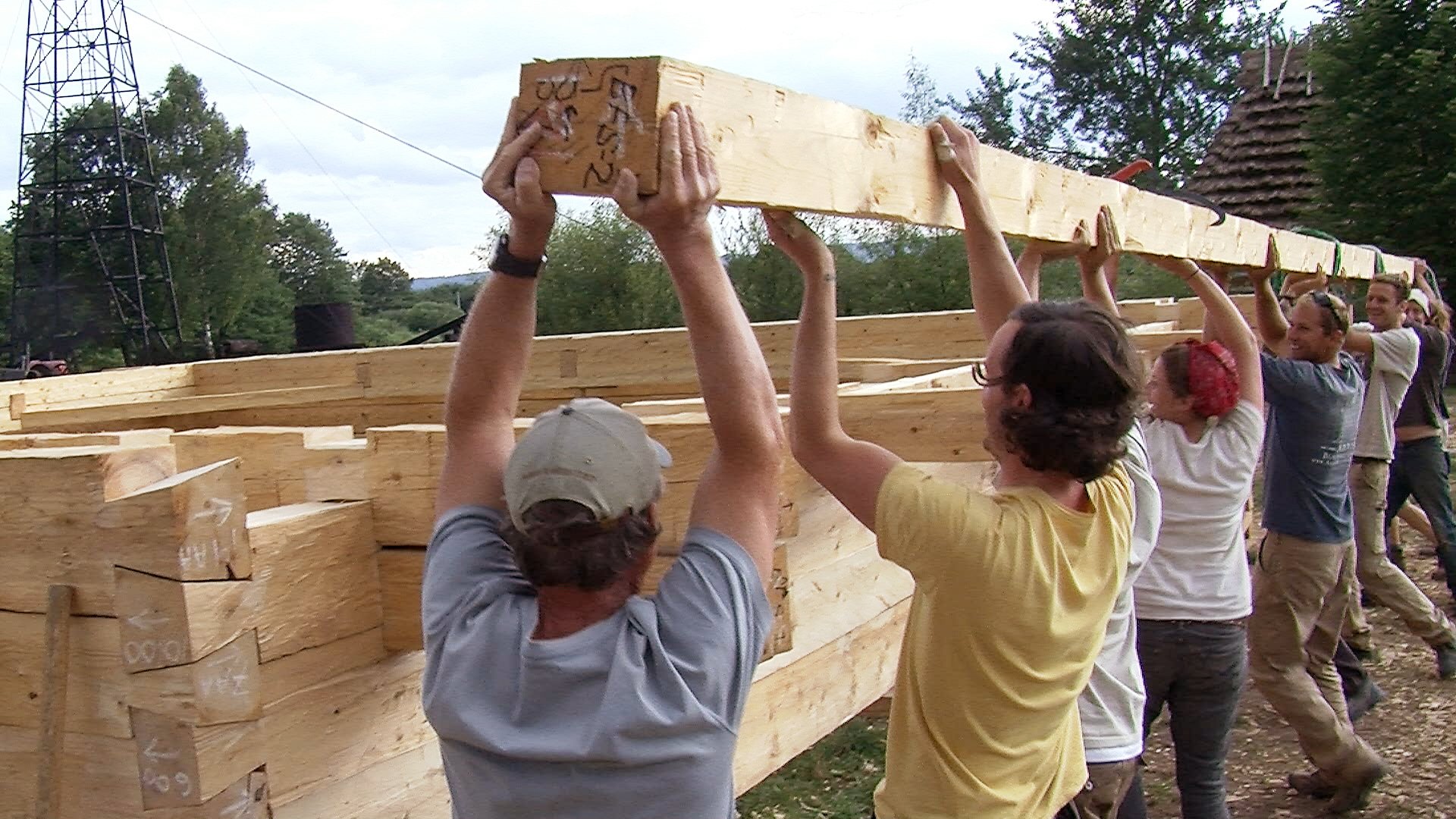



Illuminating history hands-on
Handshouse Studio is a non-profit, innovative, educational organization that creates adventurous hands-on projects with communities, institutions, and partners around the world as a way to illuminate history, understand science, and perpetuate the arts. This passion for learning-by-doing inspired Handshouse Studio to develop the MAKING/HISTORY Wooden Synagogue Project; bringing together hundreds of artists, scholars, historians, and students over the course of more than 10 years researching, and reconstructing models and significant portions of several 17th-18th century wooden synagogues in an effort to understand more about the material culture that once stood in communities across the Polish-Lithuanian Commonwealth.
Handshouse Studio’s MAKING/HISTORY projects energize history outside of the traditional classroom through the reconstruction of large historic objects. Through the intensive investigation of a single object, doors open to a wide range of related subjects—usually studied independently—creating a richly layered understanding of a moment in history, a literal three-dimensional view of an historic object, and an interactive and engaging understanding of who built the object, how it was built, and why.
Because of the extensive hands-on research and educational philosophy demonstrated in the MAKING/HISTORY: Wooden Synagogue Project, Handshouse Studio was invited to embark upon the ambitious Gwoździec Re!construction, bringing the educational mission of learning-by-doing to the professional exhibition quality work of recreating the Gwoździec Synagogue’s roof, ceiling, and bimah for the POLIN Museum.
Gwoździec Re!construction: An Actual Object
“What constitutes an “original” or “actual” or “authentic” object? The Gwoździec wooden synagogue roof and ceiling is a new kind of object. This is the genius of Handshouse Studio. Their mission is to recover lost objects, and their motto is “learn by building.”
In 2007, Michael Berkowicz introduced me to Rick and Laura Brown at a cafe in Lower Manhattan and it was love at first sight. I knew then and there that we had to work together to create at least part of the great wooden synagogue that once stood in Gwoździec, near Kolomyia, for POLIN Museum of the History of Polish Jews in Warsaw. Jerzy Halbersztadt, director of the museum at the time, gave Robert Supeł and I the green light. In 2011, thanks to a generous donation by Irene Pletka, we found the way to make the dream a reality.
That summer, Handshouse Studio and the Association of the Jewish Historical Institute of Poland, together with POLIN Museum, initiated the Gwoździec Re!construction project. In thirteen educational workshops in nine cities in Poland over three summers in 2011, 2012, and 2013, hundreds of students worked shoulder-to-shoulder with an international team of historians, architects, artisans, and artists to reconstruct the unique timber roof structure and painted cupola ceiling, and to paint the bimah, the reader’s platform. The structure was then taken apart, the parts numbered and brought to Warsaw, and the building was later reassembled at the museum. The roof and ceiling, which weigh more than 25 tons, were hoisted into place and suspended from cables…
What is actual about our Gwoździec wooden synagogue is therefore not any original 18th-century wood or original painted interior, but rather the knowledge recovered from building it. This is a completely different way of defining what is “actual” about such an object. And this is why the painted ceiling and timber-framed roof of the Gwoździec synagogue, which stands proud and tall in POLIN Museum, is an actual object.
Indeed, our Gwoździec synagogue ceiling and roof are the pride of POLIN Museum. Visitors to the museum first encounter a scale model of the whole synagogue, which Handshouse made in order to understand the structure—we think of the scale model as a three-dimensional drawing— and which they so kindly donated to the museum. Then they see the timber-framed roof, only partially shingled so as to expose the structure within, rising up into the public space of the museum. There is no hint of what is under the roof until visitors enter the gallery and that is when they gasp—the painted ceiling and bimah are a revelation, a celestial canopy—some have even called it our Sistine Chapel.”
Forward from Gwoździec Re!construction, Warsaw, 4 September 2014
- Chief Curator of the POLIN Museum Core Exhibition: Barbara Kirshenblatt-Gimblett
What is a Portal to Gwoździec?
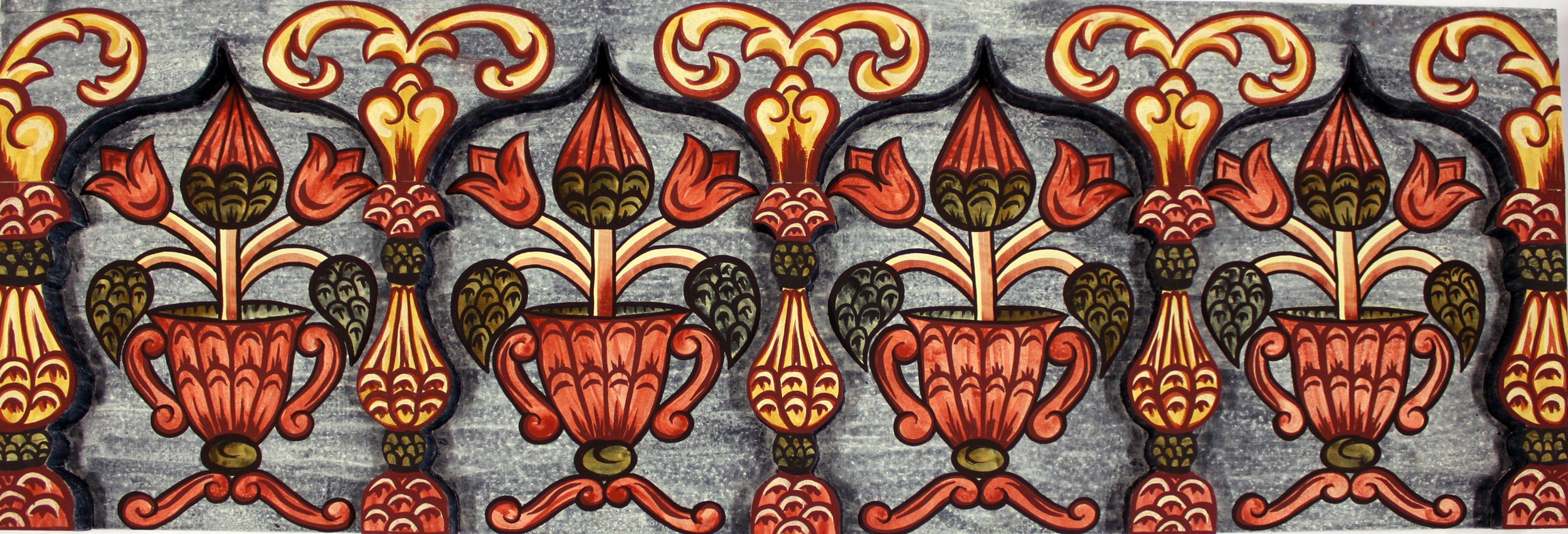
The Gwoździec Re!construction is one example of Handshouse Studio’s interdisciplinary research approach at work, and a culminating phase of the larger MAKING/HISTORY: Wooden Synagogue Project. This internationally recognized project has accumulated an extensive archive of historic records, material culture, tangible and intangible cultural heritage over the course of a 13 year hands-on investigation. Bringing together college students to work side-by side with scholars, historians, design professionals, artists, and skilled makers from around the world through project-based courses, workshops, and travel programs across the US, Poland, and Ukraine, Handshouse participants contributed to collaborative fieldwork and practical model-based explorations of Jewish and Eastern European material culture. By motivating research with the goal of recreating the Gwoździec Synagogue as precisely as possible using the tools and materials of its original makers, this project renewed awareness of the existence and relevance of 17th-18th century wooden synagogues of the Polish-Lithuanian Commonwealth. The collaborative physical product of this hands-on research resulted in stunning recreations of cultural heritage that have been recognized by historians, rabbis, curators, and politicians for their value in product and process, earning the project exhibitions in museums around the world, most notably, the reconstruction of the Gwoździec Synagogue in the POLIN Museum.
In addition to impacting the hundreds of participants involved in MAKING/HISTORY: Wooden Synagogue Project workshops, the reconstructions, their exhibitions, and Trillium Studio’s award winning documentary film, Raise the Roof, describing the project have also brought awareness of this history to millions of people, and initiated life-times of further questions to investigate.
The world-wide enthusiasm for this project has inspired a whole new question:
Can we share the intangible and tangible cultural heritage we have gathered in a way that makes the knowledge more accessible to wider audiences?
To answer this, we have turned to 21st century tools, hoping to employ cutting-edge technology to share historic processes and cultural heritage. We are currently designing a virtual sand-box, a non-linear space to explore archival images, scholarly research, material process, testimonials, and informational media in an object-centered digital user-interface, we call A Portal to Gwoździec. Bringing an open source approach to sharing the resources we have gathered, we are collaborating with the POLIN Museum for the History of Polish Jews (Warsaw, Poland), JewishArts Collaborative (Boston, MA), Trillium Studios and an interdisciplinary team of talented innovators to develop a visually stunning virtual rendering of the Gwoździec Synagogue roof and ceiling that brings the experience of visiting the space to people all over the world. Simultaneously this digital space will offer an interactive experience that opens an infinitely expandable archive of resources for visitors for their own investigations. Through combining the scalability made possible with advanced technological tools, we aim to explore innovative ways to amplify the stories embedded in historic technology and cultural heritage, making this history and other complex topics more widely accessible to a global audience.
A Space to Gather
A Portal to Gwoździec is a digital space where we can invite people together to listen, learn, and illuminate the history of the Gwoździec Synagogue together.
This is a platform where we can share :
An augmented perspective of the Gwoździec Synagogue
Interdisciplinary cultural heritage revealed through years of hands-on materials research and historic processes that culminated in the Gwoździec Re!construction.
Global archival resources and scholarship about Gwoździec and other wooden synagogues that once existed across the Polish-Lithuanian Commonwealth.
Narrative Stories about the many wooden synagogues that once stood as well as testimonials from participants of the Gwoździec Re!construction project.
Curriculum and Workshops that offer a generative way for participants to learn-by doing; illuminating cultural heritage and understanding through the physical act of reconstruction.
A Portal to Gwoździec is a place where we can continue to reawaken the lost cultural heritage of wooden synagogues.
Creating the Portal is just the beginning.
Help us share the world of the Gwoździec Synagogue together.

Building the Archive
What would be in the archive?
Over more than a decade of hands-on exploration, Handshouse Studio produced extensive records of the historical material and process research, recovering the knowledge of how to paint the elaborate imagery and iconography that colorfully covered the walls and ceiling of the Gwoździec prayer hall. These kinds of processes are examples of living cultural heritage about these synagogues learned by-hand. As Barbara Kirshenblatt-Gimblett, Chief Curator of the POLIN Museum Core Exhibition noted, the Handshouse educational philosophy of learn-by-doing helps reawaken ”the knowledge of how to build them by actually building” large scale elements of the Gwoździec Synagogue.
Examples of the cultural heritage learned and practiced by-hand in the Gwoździec Re!construction
distemper painting,
18th century pigments,
analysis of mark-making and brush work,
observations of the style of the original artists,
Hebrew calligraphy,
traditional carpentry, log building, and timber framing
This knowledge is valuable to the continued work of recovering this lost history. We hope to find the funding and expertise to log and organize as much of this living cultural information as we can into a functional archive that helps preserve and pass what has been relearned to future generations.














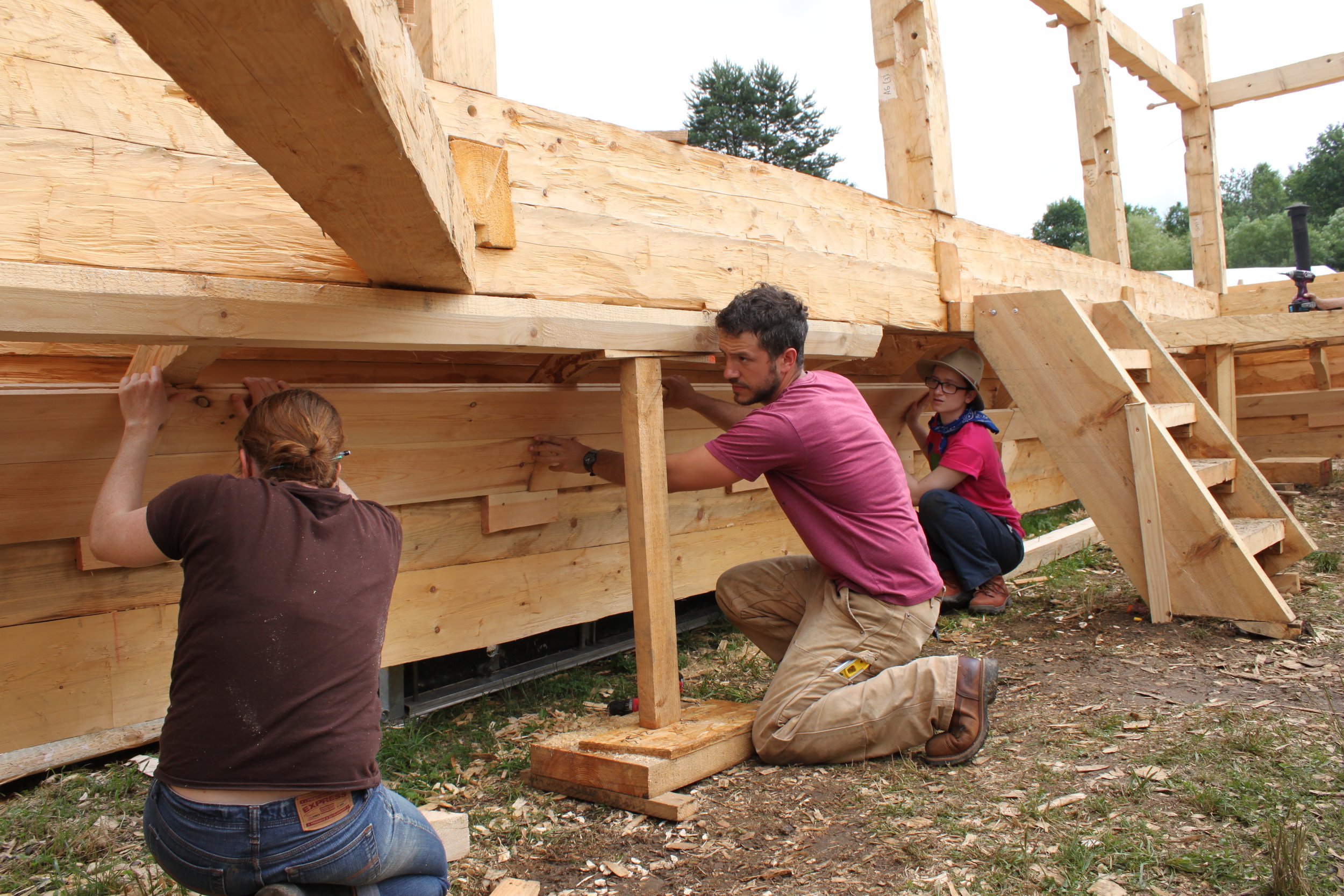






The calls for access to our research, and continued interest in our unique hands-on educational approach lead sparked the next chapter of the MAKING/HISTORY: Wooden Synagogue Project.
What is the goal of the archive?
The goal of this digital platform is to create a place to make records of Gwoździec and other 17th-18th century wooden synagogues of the Polish-Lithuanian commonwealth available.
The hope is that A Portal to Gwoździec will help us connect our communities, and garner more participation in the extensive process of understanding this history. If we can share what we have learned perhaps we can continue investigation together, furthering understanding of cultural heritage yet to be illuminated.
What we need to reach this goal
To log, digitize, organize years of Handshouse Studio research and process records.
To transcribe and log hours of documentary footage showing process research taken throughout the MAKING/HISTORY Wooden Synagogue Project and Gwoździec Re!construction.
To design an open, expandable, and accessible interface where teachers, students, scholars, and the general public can access this information.
To work with educators and filmmakers creating process and informational modules, and curriculum to offer professional development opportunities for educators to learn how to use these resources for their own hands-on workshops.
To build an interactive 3-D user interface that allows anyone with access to the internet, the opportunity to experience “visiting” the Gwoździec synagogue reconstruction. This 3-D rendering, made possible by high resolution professional photography taken by Trillium Studios of the Handshouse Studio Gwoździec Re!construction, and cutting-edge digital technology offers visitors the experience of the space as well as close-up access of the imagery covering the surfaces.

What happens next?
Building A Portal to Gwoździec has allowed us to establish the foundation for sharing our resources. It has revealed the scope of the work left in building a comprehensive archive. We have reconstructed a part of Gwoździec Synagogue. It has opened a window into a lost world. The work has only just begun.

